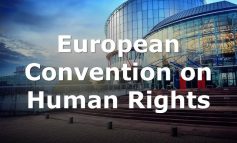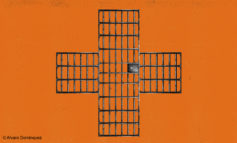Introduction
In July 2020, the Committee of Ministers of the Council of Europe adopted the revised European Prison Rules (EPR).[1] This was the culmination of work initiated in 2017 by the Council for Penological Co-operation (PC-CP), a permanent expert body operating under the aegis of the European Committee on Crime Problems (CDPC) of the Council of Europe. The revised Rules are an important development in protecting the rights of prisoners across Europe They reflect the culmination of intense discussions over a three-year span between penological experts and member States of the Council of Europe.
For these years, we had the privilege of serving as expert advisors to assist the PC-CP with the drafting and updating of the text.[2] In this paper we reflect on what led to the revision of the Rules, and the revision process itself, before focusing on the changes in one area, the body of rules governing separation and solitary confinement. These changes proved to be the most controversial and we suspect will have the most significant impact on imprisonment in Europe in years to come. In a postscript, we refer briefly to the other areas that have been revised in the 2020 EPR.
Background
By 2017, when work on the revision of the EPR began, it was clear that the impacts of the 2006 EPR had been much greater than had been expected at the time of their adoption. Between 2006 and 2017, the EPR had become embedded into the framework of European thinking about prisons. National European prison laws had been reformed with the Rules in mind.[3] In the same period, the Committee for the Prevention of Torture (CPT) also began to refer regularly to the EPR when reporting on the treatment of prisoners, while the European Court of Human Rights (ECtHR) relied explicitly on the EPR in hundreds of instances, in particular when considering the prohibition of inhuman or degrading treatment, as enshrined in Article 3 of the European Convention on Human Rights, in a prison context.[4] The latter was a significant legal development, which judge Pinto de Albuquerque of the ECtHR characterised as the gradual recognition of the EPR as embodying a form of de facto hard human rights law.[5]
If the 2006 EPR had been such a success, the immediate question that arises is, why bother to change it? The simplest answer is that the final rule of the EPR provides “The European Prison Rules shall be updated regularly”.[6] Of course, this alone is not a sufficient reason to do anything. Many Council of Europe recommendations have such provisions, and they are mostly observed in the breach.
Fortunately, in the case of the EPR there were larger forces at work. Within the Council of Europe structures, the very success of the 2006 EPR created a virtuous circle, with the CPT, the Parliamentary Assembly of the Council of Europe and the ECtHR developing new insights that were not part of the conversation in the early 2000s. The European Union, too, has joined in with various projects to support the implementation of the EPR.[7]
Outwith the magic circle of the Council of Europe, the United Nations (UN) has been playing an increasing role in prison standard setting. To take a few brief examples:
- The entering into force, shortly after the EPR, of the Optional Protocol to the UN Convention against Torture (OPCAT)[8] has encouraged the development in Europe in particular, of the National Preventive Mechanisms mandated for countries that adopt the Protocol. With this has come a growing interest in how prisons should be monitored and against what standards their performance should be measured.[9]
- The Bangkok Rules, or to give them their full title, the United Nations Rules for the Treatment of Women Prisoners and Non-custodial Measures for Women Offenders,[10] offered a gloss on the UNSMR that encouraged further reflection on how prison rules impact on women.[11]
- And then there are the UN Standard Minimum Rules for the Treatment of Prisoners (UNSMR) themselves. They were not updated for 60 years but then finally in late 2015 came some major changes to the UNSMR, now called the Nelson Mandela Rules.[12] It was not a complete rewrite, but the language was updated, together with some substantive changes in key areas, including, most importantly new restrictions of the use of solitary confinement.[13]
In the face of these larger forces, cautious steps towards updating these Rules began in 2017. Initially, consideration was restricted to updating the Commentary to the Rules. However, in the course of updating the Commentary in 2017 and 2018, it became apparent that the necessary changes could not be made through amending the Commentary alone, and it would also be necessary to amend the Rules themselves. We advised accordingly[14] and, after some debate between the PC-CP and the CDPC, it was agreed that the PC-CP would be allowed to recommend updating the rules of the EPR dealing with the following eight areas:
- Separation and solitary confinement
- Women
- Foreign nationals
- Instruments of restraint
- Requests and complaints
- Adequate prison staffing levels and minimum service guarantees
- Records and file management
- Inspections and monitoring
Updates in all eight areas were finally adopted by the CDPC in December 2019 and by the Committee of Ministers of the Council of Europe in July 2020 when it adopted the revised 2020 EPR a whole. We will return briefly to areas 2. to 8. in a postscript to this article, but our focus here is on separation and solitary confinement.
Separation and solitary confinement
The 2006 European Prison Rules contained general restrictions on the use of all special safety and security measures that might impact negatively on prisoners. The 2006 Rules did not specify, however, in what circumstances prisoners could be separated from others as a special measure. They did deal briefly with solitary confinement (the most extreme form of separation) as a disciplinary sanction, but were silent about other forms of separation. This void has now largely been filled by the 2020 amendments to the EPR.
The background to this is that since 2006, in Europe and also worldwide, there have been several important developments, both in the understanding of the deleterious effects of long-term separation and in the provision of standards to guide prison administrators in this regard.
In 2011 the CPT conducted a detailed evaluation of “solitary confinement”, broadly defined to include prisoners who are held separately as a result of a court decision, as a disciplinary sanction, for preventive purposes, or for protection purposes.[15] The CPT set general standards governing all of these forms of solitary confinement and developed standards to govern the procedures and safeguards for each of them.
In 2015, as touched upon above, the General Assembly of the United Nations amended the 1955 UNSMR. The 2015 Nelson Mandela Rules (as they are now called) include new provisions on solitary confinement, which they define as the “confinement of prisoners for 22 hours or more a day without meaningful human contact”.[16] The Nelson Mandela Rules prohibit the use of prolonged solitary confinement, that is, the solitary confinement of a prisoner for more than 15 days.[17] In addition, the Nelson Mandela Rules contain a somewhat vague requirement that “any form of involuntary separation from the general prison population” should be authorized by law or regulated by the competent administrative authority.[18] However, this requirement is not clearly linked to solitary confinement and the restrictions on its use.
Thirdly, since 2006, we have seen the further development of an impressive body of scientific evidence on the negative effects of long-term solitary confinement (broadly defined), and the acknowledgement of this at an international level. In 2008, the UN Special Rapporteur on Torture acknowledged that “[t]he weight of accumulated evidence to date points to...serious and adverse health effects”[19] of solitary confinement while, in 2011, the CPT reiterated that it "can have an extremely damaging effect on the mental, somatic and social health of those concerned.”[20] Leading up to the final discussions on the EPR, the World Medical Association adopted a statement repeating the Nelson Mandela Rules’ call for a prohibition on prolonged solitary confinement, acknowledging that it may amount to torture or inhuman and degrading treatment.[21] Shortly after the revised EPR’s adoption, a consensus statement was adopted by the world’s leading researchers on solitary confinement, reaffirming that existing evidence “clearly establishes that solitary confinement subjects prisoners to significant risk of serious harm” and accordingly it should only be used when absolutely necessary.[22]
The 2020 amendments to the EPR build on these developments but adopt a somewhat different approach. The key innovation is the introduction of a dedicated new provision, Rule 53A, focusing solely on separation as a special security or safety measure. This is bolstered by important amendments to Rule 53, which deals with special high security and safety measures more broadly, and Rule 60.6, which considers solitary confinement in a disciplinary context.
Separation in the EPR
There are four broad types of solitary confinement, or separation, identified in research. These are: solitary confinement as a result of a court decision; solitary confinement as a disciplinary measure; ‘administrative’ solitary confinement, for purposes of good order or prevention; and solitary confinement for an individual’s own protection.[23]
Rule 53A of the EPR deals with all forms of separation in the context of special high security and safety measures. In the context of the Rules, this covers all forms of separation except separation for disciplinary purposes — which, as stated above, is dealt with in Rule 60. Importantly, this is the case regardless of how national prison authorities refer to such separation; it may be called ‘separation’, ‘segregation’, ‘isolation’ or even ‘solitary confinement’.
Rule 53A requires that “prisoners who are separated shall be offered at least two hours of meaningful human contact a day”. It follows from this provision that all prisoners who do not have access to such contact are being held in solitary confinement as defined in the UN Nelson Mandela Rules, and in breach of Rule 53A of the EPR. In this sense, the EPR actually prohibit solitary confinement (at least as defined by the Nelson Mandela Rules) for all purposes except disciplinary ones. For this reason, ‘separation’ is used as a distinct term in Rule 53A.
Within the EPR, ‘solitary confinement’ may be understood as the most severe form of separation, where meaningful human contact is most restricted. The revised EPR adopt a similar definition to the Nelson Mandela Rules, referring to solitary confinement as "the confinement of a prisoner for more than 22 hours a day without meaningful human contact”.[24] Prisoners who are subject to disciplinary punishment are therefore the only prisoners who, in terms of the EPR, do not have a right to two hours of meaningful contact a day. However, the use of solitary confinement as a disciplinary punishment remains subject to restrictions. Those restrictions are set out in the amended Rule 60.6 and are discussed further below.
Returning to separation for all other purposes, it is important to note that authorities must not only ensure at least two hours of meaningful human contact a day, but also comply with other detailed requirements. These include not only those set by Rule 53A but also the requirements of Rule 53, which applies to special high security or safety measures more broadly. Rule 53 has been amended to emphasise that all special safety and security measures, of which separation is one, should “only be applied in exceptional circumstances and only for as long as security or safety cannot be maintained by less restrictive means”.[25] Similarly, the amended Rule 53 makes clear that the lawful imposition of special security or safety measures is dependent on their proportionality, emphasising: “Such measures shall only be based on the current risk that a prisoner poses, shall be proportionate to that risk and shall not entail more restrictions than are necessary to counter that risk”.[26] Rule 53 also sets out procedures that must be followed for the imposition of all special high security or safety measures, including separation.
In addition to the “two hours of meaningful human contact” requirement, Rule 53A specifies a number of other standards that must be met when prisoners are separated. These include a requirement that “prisoners who are separated shall not be subject to further restrictions beyond those necessary for meeting the stated purpose of such separation”.[27] Implicit in this rule is the principle of proportionality, expressed more generally in Rule 53.8, in the specific context of separation. This principle is developed further in Rule 53A.f, which provides that “the longer a prisoner is separated from other prisoners, the more steps shall be taken to mitigate the negative effects of their separation by maximising their contact with others and by providing them with facilities and activities.” The principle of proportionality is particularly important in the context of separation, which is why it is emphasised so strongly. It is worth recalling that none of the forms of separation considered in Rule 53A, or 53 more broadly, are strictly speaking intended to punish prisoners. Rule 53A reflects an understanding that, regardless of the stated purpose of separation, the impact of removing social contact and external stimuli can have extremely punishing effects on prisoners.[28] It is vital that prison authorities are mindful of these unintended, but devastating impacts, and accordingly seek to prevent and mitigate against these.
Of course, some prisoners may be inherently more vulnerable to these devastating impacts. Accordingly, Rule 53A.b. requires that any “decision on separation shall take into account the state of the prisoners concerned and any disabilities they may have which may render them more vulnerable to the adverse effects of separation”. If a prisoner’s physical or mental health is adversely affected, regardless of any pre-existing conditions, “action shall be taken to suspend [separation]… or to replace it with a less restrictive measure”.[29] Together, these rules seek to ensure that, as with special security or safety measures more generally, separation is seen as a measure that is “exceptional” in nature.[30]
Solitary Confinement in the EPR
As discussed above, within the lexicology of the EPR, ‘solitary confinement’ is an extreme form of separation, where a prisoner is provided with less than two hours a day of meaningful human contact. As there is now strong scientific evidence that separation with such a severe restriction on contact can have a very negative effect on prisoners,[31] the revised EPR require that solitary confinement may only be imposed as a punishment. Even then, its imposition is subject to a range of limitations. In some instances, its use is totally prohibited: Rule 60.6.a provides that solitary confinement shall “never be imposed on children, pregnant women, breastfeeding mothers or parents with infants in prison” – a provision that reiterates principles set down by the UN Committee on the Rights of the Child[32] and the UN Bangkok Rules on women prisoners.[33] Rule 60.6.b also requires that solitary confinement shall “not be imposed on prisoners with mental or physical disabilities when their condition would be exacerbated by it”.[34]
Rule 60 nonetheless requires authorities to be mindful of the negative effects of solitary confinement on prisoners more generally. Rule 60.6.b requires that “[w]here solitary confinement has been imposed, its execution shall be terminated or suspended if the prisoner’s mental or physical condition has deteriorated”. There is a further restriction on the use of solitary confinement in Rule 60.6.e, which provides: “Where a punishment of solitary confinement is imposed for a new disciplinary offence on a prisoner who has already spent the maximum period in solitary confinement, such a punishment shall not be implemented without first allowing the prisoner to recover from the adverse effects of the previous period of solitary confinement.” In this sense, Rule 60 reflects an unfortunate reality that prison authorities continue to rely on, and are reluctant to relinquish, solitary confinement as a disciplinary measure. Rule 60 seeks to ensure authorities remain mindful of the negative impacts of solitary confinement; unguarded, it may amount to torture or inhuman and degrading treatment or punishment, which is (according to Rule 60.6c and as part of European and international law more broadly[35]) never permissible.
Unlike the CPT standards or the Nelson Mandela Rules, the EPR still do not specify a maximum number of days for which solitary confinement may be imposed. This is unfortunate, as a bright line prohibition is an effective safeguard against abuse. However, in addition to requiring that solitary confinement shall never amount to torture, Rule 60.6.c reiterates the exceptionality of solitary confinement as a measure. It requires that solitary confinement shall only ever be imposed for a specified period, which shall be as short as possible”. In regard to this ‘specified period’, Rule 60.6.d requires that “[t]he maximum period for which solitary confinement may be imposed shall be set in national law”. This is significant, as it compels national legislatures to compensate for the failure of the EPR to set an appropriate maximum period of solitary confinement. On this point, the Commentary to the EPR[36] emphasises that a 15-day limit has been set by the Nelson Mandela Rules, while the CPT has repeatedly emphasised its own 14-day limit[37] – standards which member States are obliged to bear in mind. If national legislatures were to set a maximum of longer than the 15 days prescribed by the Nelson Mandela Rules, they are likely to face a challenge before the European Court of Human Rights, which may well hold that a longer maximum period would amount to inhuman or degrading punishment and thus contravene Article 3 of the European Convention on Human Rights. In coming to such a conclusion, the Court would be able to rely on the scientific evidence, including the World Medical Association’s Statement on Solitary Confinement, which states that solitary confinement should never exceed 15 consecutive days.[38]
The amended EPR present several difficult interpretative challenges. None of these is as complex as the term, “meaningful human contact”, which the European Rules share with their UN counterpart, the Nelson Mandela Rules.[39] Neither instrument specifies what the term precisely means, but some indications are beginning to emerge of how it is likely to be used in practice. First indications for Europe come from the CPT, which has applied the concept of ‘meaningful human contact’ in a number of its reports on national prisons.[40] When so doing, the CPT has explicitly adopted[41] the definition contained in the ‘Essex paper’, which seeks to provide expert guidance on the application of the Nelson Mandela Rules. This definition captures ‘meaningful human contact’ as “the amount and quality of social interaction and psychological stimulation which human beings require for their mental health and well-being. Such interaction requires the human contact to be face to face and direct (without physical barriers) and more than fleeting or incidental, enabling empathetic interpersonal communication. Contact must not be limited to those interactions determined by prison routines, the course of (criminal) investigations or medical necessity.”[42] For their part, the revised EPR in turn refer to this definition in their Commentary — but it is clear that the term requires further unravelling.
Conclusion on Separation and Solitary Confinement
In due course, national prison systems will have to produce detailed guidance for their staff on how to provide daily meaningful human contact for their prisoners. Failure to do so may well result in what was intended to be mere separation to be regarded by monitoring bodies or courts as an illegitimate form of solitary confinement.
The importance of this new web of rules can be illustrated by a single example. The risk that a prisoner has COVID-19 is undoubtedly a ground for separating such a prisoner.[43] On the other hand, it is clearly not a ground for subjecting such a prisoner to disciplinary solitary confinement. The prisoner who has, or may have, COVID-19 should therefore have access to at least two hours of meaningful human contact daily and also all the other rights and facilities set out in Rule 53A. Prison authorities have to think carefully how to do so, as failing to provide these rights and facilities for prisoners in COVID-19 separation will expose the authorities to allegations that they are meting out inhuman and degrading treatment to these prisoners. More positively, the amended EPR may encourage widespread reforms in the way in which prisoners are treated in the ‘prison within a prison’[44] in which they are segregated. This could lead to a long-term reform of prison regimes throughout Europe.
Growing recognition of the EPR by the ECtHR made the process of amending the Rules harder, as member States were rightly concerned to examine carefully rules that will be considered binding upon their prison services, even if indirectly. However, now that the changes have been adopted, the increased status of the EPR is a heartening development, for it should encourage states to apply the modified provisions. If they do not, they run the risk that they will be held responsible by the Court and others for failing to meet their legal obligations. If they do apply the new provisions, we can expect prisoners throughout Europe to be treated more humanely. This is the positive outcome on which we should be focusing.
Postscript: the other seven areas of revision
- Women: a general clause has been added to the rule on women in the 2006 EPR, which had been highlighted as a remaining weakness in the 2006 Rules.[45] It states: “Specific gender sensitive policies shall be developed and positive measures shall be taken to meet the distinctive needs of women prisoners in the application of these rules.”[46] This was influenced by the first basic principle of the Bangkok Rules, which requires for account to be taken of the “distinctive needs” of women prisoners in the application of the Nelson Mandela Rules, notably Rule 6 — the principle of non-discrimination.[47] A few further adjustments have been made to strengthen the EPR in this area. These, too, are largely a reflection of the Bangkok Rules, for which a European counterpart is desirable and was called for by civil society submissions in relation to the EPR revision.[48] There is clearly scope for a fuller Council of Europe recommendation on women’s prisons, which would enable this issue to be addressed more systematically.
- In the case of foreign nationals there has been an important further European recommendation post-2006, the 2012 Recommendation of the Committee of Ministers to member States concerning foreign prisoners.[49] Changes to the existing Rule 37 build on this Recommendation. The amended Rule 37 now emphasises the importance of taking positive measures to ensure that the distinctive needs of prisoners who are foreign nationals are met,[50] and that they receive programmes and access to the outside world that are on a par with those available to national prisoners.[51] They are also entitled to be considered for early release in the same way as other prisoners.[52]
- The current rule dealing with instruments of restraint (Rule 68) has been strengthened by including principles restricting their use. Instruments of restraint should be used only when authorised by law and then only when no lesser form of control would be effective to address the risks posed by a prisoner.[53] Moreover, this should be done in the least intrusive way possible and for the minimum period required.[54]
- The rule of the EPR on requests and complaints (Rule 70) has been tightened considerably. Much of the change is procedural and inspired both by the need to set a clear process for prisoners to follow if they are unhappy about their complaints not being addressed, and by the requirement of European human rights law that domestic remedies must be exhausted before the ECtHR can be approached to intervene.[55] It must be clear what the internal domestic remedies are, so that one can judge whether they have been used to the full.
- There has been a small but strategic change to Rule 83, which now provides that prisons must be adequately staffed at all times and be “capable of withstanding operational emergencies”.[56] The intention here is to ensure that staff shortages, during a strike, for example, cannot be used as a justification for keeping prisoners locked in their cells for excessive periods.
- The rules on records and file management have been much expanded, and a new rule, Rule 15A introduced. This change is driven by the increasing recognition, reflected in detailed provisions in the Nelson Mandela Rules,[57] that good records are essential, not only for the protection of prisoners (and of staff against claims of abuse) but also for the smooth operation of the prison system as a whole.
- Finally, there are now much more extensive provisions in Rules 92 and 93 that deal with inspections and monitoring in the 2020 EPR. Incorporating changes presaged in the Nelson Mandela Rules,[58] the revised EPR give more investigatory powers to independent monitors.[59] A valuable further change is a specific provision that recommendations made by independent monitors must be considered by the prison authorities, who are required to respond to them, explaining, not only to the monitors but also to the public, whether they will adopt the recommendations and if not, why not.[60]
NOTES
[1] Recommendation Rec(2006)2-rev of the Committee of Ministers to member States on the European Prison Rules, Adopted by the Committee of Ministers on 11 January 2006, at the 952nd meeting of the Ministers' Deputies and revised and amended by the Committee of Ministers on 1 July 2020 at the 1380th meeting of the Ministers' Deputies (The European Prison Rules) https://www.coe.int/en/web/human-rights-rule-of-law/-/revised-european-prison-rules-new-guidance-to-prison-services-on-humane-treatment-of-inmates
[2] When assisting the PC-CP, we were particularly grateful to have the support of representatives from the Committee for the Prevention of Torture (CPT), Hugh Chetwynd, and of the European Court of Human Rights, Kresimir Kamber.
We are also particularly grateful to Dr Sharon Shalev, Research Associate at the University of Oxford, for her assistance with the provisions on separation and solitary confinement. None of these persons is responsible for the various proposals we put forward to the PC-CP nor, obviously, for the text that was finally adopted by the Committee of Ministers of the Council of Europe.
[3] Council of Europe, Report presented to the 16th Conference of Directors of Prison Administration: Summary of the replies given to the questionnaire regarding the implementation of the most recent Council of Europe standards related to the treatment of offenders while in custody as well as in the community (2011), Strasbourg: Council of Europe.
[4] Dirk van Zyl Smit “Legitimacy and the Development of International Standards for Punishment” in J Tankebe and A Liebling (eds.) Legitimacy and Criminal Justice: an International Exploration Oxford: Oxford University Press, 2013. Pp. 267-292.
[5] Muršić v. Croatia ECtHR GC (Application no. 7334/13), 20 October 2016, partly dissenting judgment of Judge Pinto de Albuquerque, para. 41.
[6] The European Prison Rules, Rule 108.
[7] See the 2017 briefing note from the European Parliament, Prison conditions in the Member States:
selected European standards and best practices, https://www.europarl.europa.eu/RegData/etudes/BRIE/2017/583113/IPOL_BRI(2017)583113_EN.pdf
[8] Optional Protocol to the Convention against Torture and other Cruel, Inhuman or Degrading Treatment or Punishment, Adopted on 18 December 2002 at the fifty-seventh session of the General Assembly of the United Nations by resolution A/RES/57/199 entered into force on 22 June 2006
[9] Mary Rogan, "Prison Inspection and Monitoring: The Need to Reform European Law and Policy" (2019), European Journal on Criminal Policy and Research 1-21.
[10] United Nations Rules for the Treatment of Women Prisoners and Non-custodial Measures for Women Offenders (the Bangkok Rules), as adopted Resolution adopted by the General Assembly on 21 December 2010 (A/RES/65/229).
[11] Penal Reform International and Thailand Institute of Justice, Guidance Document on the United Nations Rules on the Treatment of Women Prisoners and Non-custodial Measures for Women Offenders (The Bangkok Rules) (2013), London: PRI. https://www.penalreform.org/resource/bangkok-rules-guidance-document-index-implementation/
[12] The United Nations Standard Minimum Rules for the Treatment of Prisoners (the Nelson Mandela Rules), General Assembly resolution 70/175, annex, adopted on 17 December 2015 https://www.unodc.org/documents/justice-and-prison-reform/Nelson_Mandela_Rules-E-ebook.pdf
[13] See: Rules 43-46 of the Nelson Mandela Rules
[14] See: Dirk van Zyl Smit and Harvey Slade, Updating the European Prison Rules: An Analytical Report, PC-CP (2018) 4rev https://rm.coe.int/pc-c-2018-4rev-e-memo-to-cdpc-updating-the-european-prison-rules-analy/16807c0eba
[15] European Committee for the Prevention of Torture and Inhuman or Degrading Treatment or Punishment (CPT), 21st General Report of the CPT, (CPT/Inf (2011) 28) https://rm.coe.int/1680696a88
[16] Rule 44 of the Nelson Mandela Rules.
[17] Rules 43 and 44 of the Nelson Mandela Rules
[18] Rule 37 of the Nelson Mandela Rules.
[19] United Nations General Assembly, Interim Report of the Special Rapporteur on Torture and Other Cruel, Inhuman or Degrading Treatment or Punishment (A/63/175, Sixty third session, Distr: 28 July 2008), at 82.
[20] European Committee for the Prevention of Torture and Inhuman or Degrading Treatment or Punishment (CPT), 21st General Report of the CPT, (CPT/Inf (2011) 28), p39 para 53 https://rm.coe.int/1680696a88
[21] World Medical Association, WMA Statement on Solitary Confinement, revised by the 70th WMA General Assembly, Tbilisi, Georgia, October 2019 https://www.wma.net/policies-post/wma-statement-on-solitary-confinement/#_ftn1
[22] Craig Haney et al, ‘Consensus Statement from the Santa Cruz Summit on Solitary Confinement and Health’ (2020), 115 Northwestern University Law Review 335.
https://scholarlycommons.law.northwestern.edu/nulr/vol115/iss1/9
[23] European Committee for the Prevention of Torture and Inhuman or Degrading Treatment or Punishment (CPT), 21st General Report of the CPT, (CPT/Inf (2011) 28), p43-44 https://rm.coe.int/1680696a88
[24] Rule 60.6a of the European Prison Rules
[25] Rule 53.1 of the European Prison Rules
[26] Rule 53.8 of the European Prison Rules
[27] Rule 53A.d of the European Prison Rules
[28] Sharon Shalev, "A Sourcebook on Solitary Confinement” (2008), (London: Mannheim Centre for Criminology, London School of Economics), p9-25 https://www.solitaryconfinement.org/sourcebook
[29] Rule 53A.i. of the European Prison Rules
[30] Rule 53.2 of the European Prison Rules
[31] Sharon Shalev, "A Sourcebook on Solitary Confinement” (2008), (London: Mannheim Centre for Criminology, London School of Economics), p9-25 https://www.solitaryconfinement.org/sourcebook
[32] UN Committee on the Rights of the Child, General Comment No. 10 (2007), CRC/C/GC/10, at para. 89.
[33] Rule 22 of the Bangkok Rules
[34] As similarly required by Rule 45.2 of the Nelson Mandela Rules
[35] Article 3 of the European Convention on Human Rights; Article 7 of the International Covenant on Civil and Political Rights
[36] European Committee on Crime Problems (CDPC) and Council for Penological Co-operation (PC-CP), Revised Rules and Commentary to Recommendation CM/Rec(2006)2 of the Committee of Ministers to member States on the European Prison Rules (2019) https://rm.coe.int/pc-cp-2018-15-e-rev-7-19-11-19/168098dec6 .
[37] See European Committee for the Prevention of Torture and Inhuman or Degrading Treatment or Punishment (CPT), 21st General Report of the CPT, (CPT/Inf (2011) 28), p43 para 56 https://rm.coe.int/1680696a88
[38] World Medical Association, WMA Statement on Solitary Confinement, revised by the 70th WMA General Assembly, Tbilisi, Georgia, October 2019 https://www.wma.net/policies-post/wma-statement-on-solitary-confinement/#_ftn1
[39] Rule 44 of the Nelson Mandela Rules
[40] Report to the Albanian Government on the visit to Albania carried out by the European Committee for the Prevention of Torture and Inhuman or Degrading Treatment or Punishment (CPT) from 20 to 30 November 2018 [CPT/Inf (2019) 28], paragraph 106; Report to the Government of the United Kingdom on the visit to the United Kingdom carried out by the European Committee for the Prevention of Torture and Inhuman or Degrading Treatment or Punishment (CPT) from 17 to 25 October 2018 [CPT/Inf (2019) 29], paragraphs 63, 64, 72, 73, 74, 79, 80, 90 and 95; Report to the Norwegian Government on the visit to Norway carried out by the European Committee for the Prevention of Torture and Inhuman or Degrading Treatment or Punishment (CPT) from 28 May to 5 June 2018 [CPT/Inf (2019) 1], paragraphs 79 and 82; Report to the Slovak Government on the visit to the Slovak Republic carried out by the European Committee for the Prevention of Torture and Inhuman or Degrading Treatment or Punishment (CPT) from 19 to 28 March 2018 [CPT/Inf (2019) 20], paragraph 89; Report to the Greek Government on the visit to Greece carried out by the European Committee for the Prevention of Torture and Inhuman or Degrading Treatment or Punishment (CPT) from 10 to 19 April 2018 [CPT/Inf (2019) 4], paragraph 85; Report to the Government of the United Kingdom on the visit to Northern Ireland carried out by the European Committee for the Prevention of Torture and Inhuman or Degrading Treatment or Punishment (CPT) from 29 August to 6 September 2017 [CPT/Inf (2018) 47], paragraphs 56 and 74; Report to the Portuguese Government on the visit to Portugal carried out by the European Committee for the Prevention of Torture and Inhuman or Degrading Treatment or Punishment (CPT) from 27 September to 7 October 2016, paragraph 80.
[41] Report to the Government of the United Kingdom on the visit to the United Kingdom carried out by the European Committee for the Prevention of Torture and Inhuman or Degrading Treatment or Punishment (CPT) from 17 to 25 October 2018 [CPT/Inf (2019) 29], paragraph 74 (footnote 55); Report to the Norwegian Government on the visit to Norway carried out by the European Committee for the Prevention of Torture and Inhuman or Degrading Treatment or Punishment (CPT) from 28 May to 5 June 2018 [CPT/Inf (2019) 1], paragraph 82 (footnote 2).
[42] Essex paper 3: Initial guidance on the interpretation and implementation of the Nelson Mandela Rules, Penal Reform International and the Essex Human Rights Centre at the University of Essex, 2017, pp.88-89.
[43] See: Penal Reform International, Coronavirus: Preventing harm and human rights violations in criminal justice systems (2020) https://www.penalreform.org/resource/coronavirus-preventing-harm-and-human-rights-violations/
[44] Ramirez Sanchez v. France, No. 59450/00 (ECtHR, Grand Chamber, 4 July 2006), paragraph 139
[45] Andrea Huber, “The relevance of the Mandela Rules in Europe” (2016), 17 ERA Forum 299-310.
[46] Rule 34.1 of the European Prison Rules.
[47] Rule 1 of the Bangkok Rules; Rule 6 of the Nelson Mandela Rules.
[48] See: Penal Reform International and Association for the Prevention of Torture, Submission by Penal Reform International and the Association for the Prevention of Torture to the 19th meeting of the Working Group of the Council for Penological Co- operation (PC-CP), 17-19 September 2018 in Strasbourg (2018), p10 https://rm.coe.int/submission-to-pc-cp-wg-on-european-prison-rules-revision-12-09-18-fina/16808d564e
[49] Recommendation CM/Rec(2012)12 of the Committee of Ministers to member States concerning foreign prisoners, Adopted by the Committee of Ministers on 10 October 2012 at the 1152nd meeting of the Ministers’ Deputies https://search.coe.int/cm/Pages/result_details.aspx?ObjectId=09000016805c9df0
[50] Rule 37.1 of the European Prison Rules.
[51] Rule 37.2 of the European Prison Rules.
[52] Rule 37.8 of the European Prison Rules.
[53] Rule 68.1 of the European Prison Rules.
[54] Rules 68.2 and 68.3 of the European Prison Rules.
[55] See: Kresimir Kamber, “Remedies for breaches of prisoners’ rights in the European Prison Rules” (2020), New Journal of European Criminal Law.
[56] Rules 83a and 83b of the European Prison Rules.
[57] Rules 6-10 of the Nelson Mandela Rules.
[58] Rules 83-85 of the Nelson Mandela Rules.
[59] Rule 93.2 of the 2020 EPR.
[60] Rule 93.6 read with Rule 93.7 of the 2020 EPR.

















